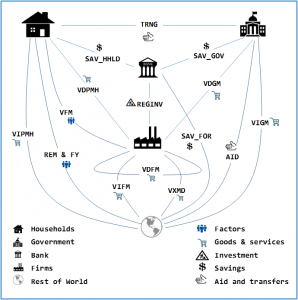Customized CGE Models and Economy-wide Analysis
Our focus at ImpactECON is economic modeling which provides insight. Our team have been providing economic modeling services for over 20 years. The core of our approach utilizes Computable General Equilibrium (CGE) models.
CGE models recognize that a price change in one market can lead to impacts and price changes in other markets; providing a comprehensive picture of the economy-wide linkages essential to sound recommendations.Global CGE models can be used to examine the impact of changes in government policies or other environmental factors on the global economy. For example:
- the impact of regional free trade agreements such as the Trans-Pacific Partnership;
- trade facilitation efforts designed to reduce delays in the movement of goods across borders;
- disruptions in trade and supply chains due to natural disasters;
- changes in domestic tax policy on fuel or other government initiatives;
- expansion of migrant flows into Europe;
- implementation of carbon emissions schemes;
- among others.
ImpactECON’s staff have extensive experience customizing and extending CGE models and databases to analyze the impact of real world issues. We specialize in bringing enhanced data and theory into both dynamic and comparative static GTAP-based analysis. Our main areas of expertise include the:
- provision of detailed industry and commodity impacts across multiple countries;
- impacts on global trade flows and supply chains;
- analysis of multilateral and regional trade agreements, including non-tariff barriers and trade facilitation;
- assessment of the implications for trade balances, investment and foreign capital flows;
- analysis of the budgetary implications for governments; and
- investigation of the employment effects and changes in labor force composition and wages and how these impact households.
CGE Modeling at ImpactECON
Recently, our staff developed a global model and database that can be used to investigate the impact of economic policies and environmental factors on global supply chains. By differentiating between imported intermediates and imported final goods this essentially creates different commodities that are subject to distinct trade restrictions and policies, that can also be investigated using these tools.
The MyGTAP model, also developed by staff at ImpactECON, allows users to undertake country-specific analysis examing the impact of policies on multiple households and factors of production, while maintaining the global linkages found in the standard GTAP model. This model also enhances analysis of government behavior and foreign income flows, such as foreign aid.
In cases where policy implementation and impacts are spread over a longer time span, or where the impacts of dynamic growth are important, we employ dynamic CGE models such as the Dynamic GTAP Model (GDyn) or ImpactECON’s dynamic supply chain model (IESCDyn).
The staff at ImpactECON also have experience with numerous other GTAP models including Migration models (GMig2 and GMig2Dyn), the GTAP PE-GE model, and the energy model (GTAP-E), as well as a number of GAMs-based models including the GLOBE model, the OECD METRO model and the World Bank’s R23 model.
ImpactECON maintains the software required for source code development, which means we can create unique models and analysis and distribute these materials with minimal client license requirements. This capability also increases the distribution potential within your organization of the model and code we create for you, adding value to your investment in a customized product.
Whether you require customized model coding, ‘what-if’ scenario development, impact analysis, or data for input into your own analysis, ImpactECON can help you meet your goals.

